Last updated: January 15, 2020
Article
Moose: Did You Know?

NPS/Kyle Joly
Moose (Alces alces) are the largest members of the deer family, and Alaska moose (Alces alces gigas) are the largest of all the moose subspecies. The largest bull recorded at the Moose Research Station on the Kenai Peninsula in Alaska was 1,697 lbs in November, which included antlers.1 Comparatively, that bull moose was heavier than an average dairy cow!
Large Antlers
Pairs of antlers from mature bull moose average 45-50 pounds in Interior Alaska, with the heaviest weighing up to 75 pounds!2 Mature moose can grow about an inch of antler a day, which can result in a pound of antler added daily.3 Female moose don’t grow antlers.
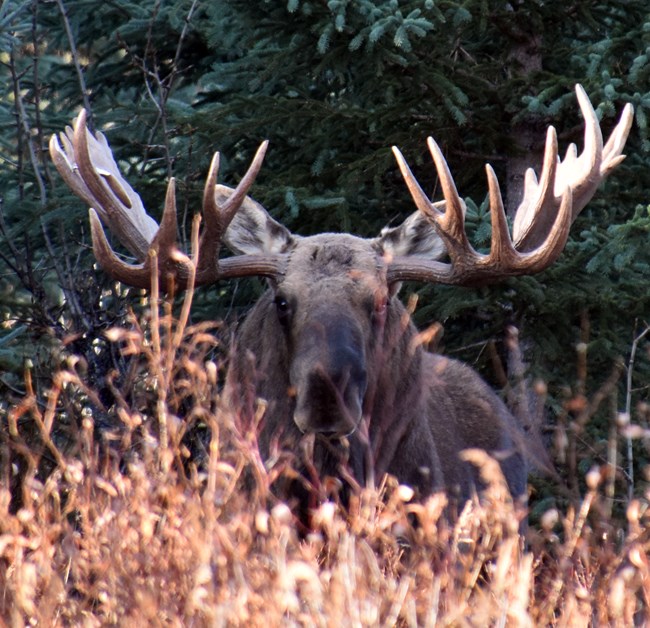
NPS/Kyle Joly
The diet of moose varies seasonally – they eat shoots and leaves in the summer and woody twigs in the winter. How much a moose has to eat varies as well. In the summer, their rumen (the first of their 4 stomachs) can weigh 90 pounds and in the winter 112 lbs!4
Moose Don't Get Cold Easily
Moose are well suited to long Alaskan winters. Scientists have not found the temperature at which a moose begins to expend energy to stay warm. Moose have been tested down to -22°F, but they weren’t cold yet!5 In fact, moose live where the coldest temperature was ever recorded in Alaska, which was -80°F along the Dalton Highway in 1971!6
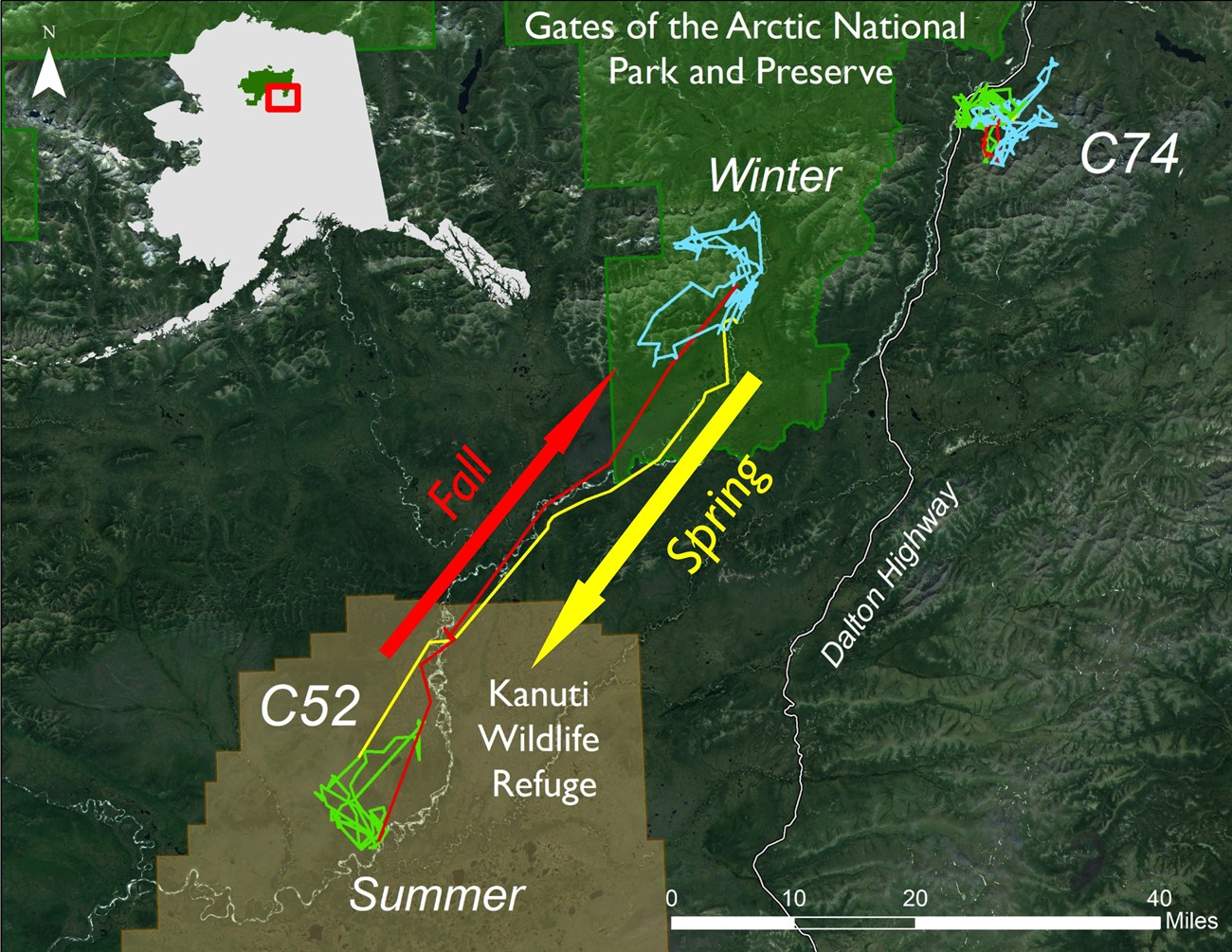
The temperature at which moose have to work to cool off by panting changes by the season due to their different coats – in winter, this is above 28°F and about 62°F in the summer.5 This is one reason why you will often see moose in lakes during the heat of summer days!
Shifting Ranges
The southern extent of the moose’s range is moving northward, likely due to warming temperatures and changing plant communities.7 Conversely, moose have moved further north in the last 150 years, likely due to shrub expansion in the arctic tundra.8
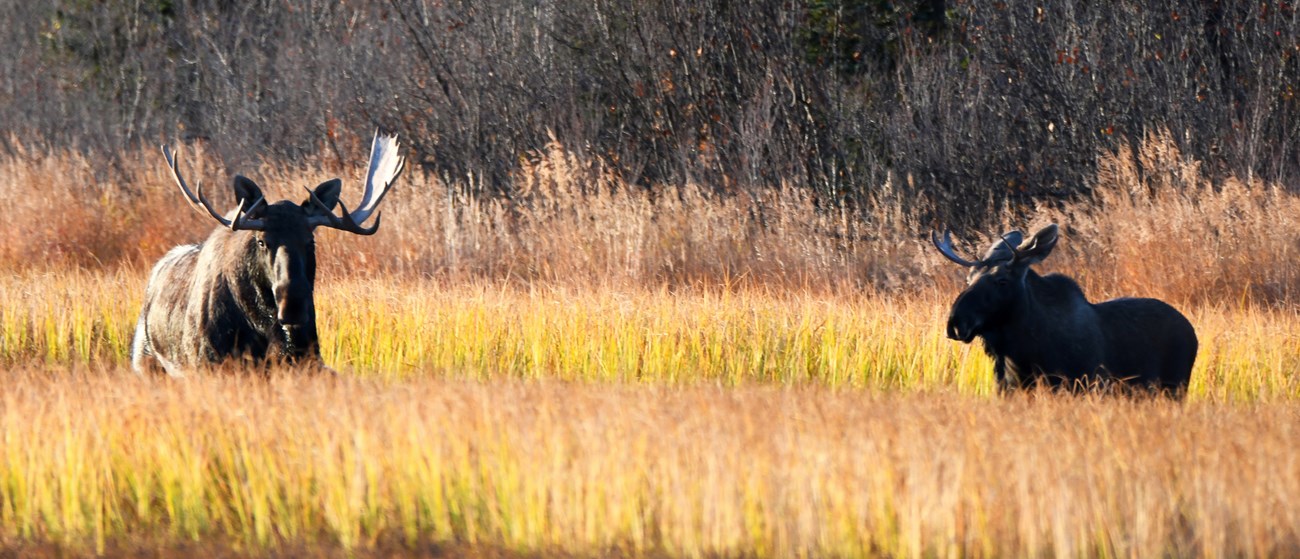
NPS/Matt Cameron
The earliest evidence of moose hunting in Alaska dates to around 13,000 years ago and comes from the Broken Mammoth archaeological site in the middle Tanana River valley.9 Moose have probably been hunted as long as people have been in Alaska.
Shifting Priorities
Males don’t eat for approximately 2 weeks during the rut10 and can lose up to 20% of their body weight. Males use their large antlers to establish dominance by sparring with other males during rut, and at peak rut the sparring may turn deadly. Remains have been found where two males became permanently locked together by their antlers, and numerous creeks around Alaska are named ‘Antler Creek’ because of this.
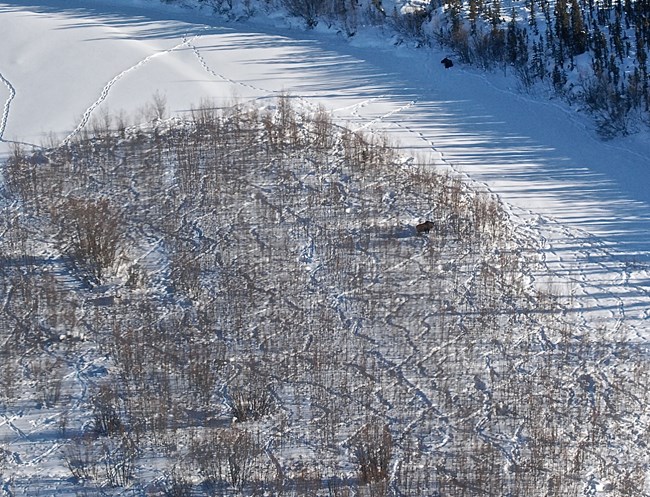
NPS/Matt Cameron
One commonly used measure of habitat quality for moose is the percentage of females that deliver twins each year.11 If a greater proportion of females have twins in the spring, the habitat is deemed to be highly productive for moose. If there are not many twins born in the spring, then the population may be food limited and could be declining if this is a new trend. Moose have been observed with triplets on rare occasions.12
Favorite Habitat
Moose prefer to eat young woody vegetation such as willow, birch and aspen. The best moose habitat is generally considered to be floodplains14 and areas burned about 15 years before due to the flush of fresh shrub regrowth!15
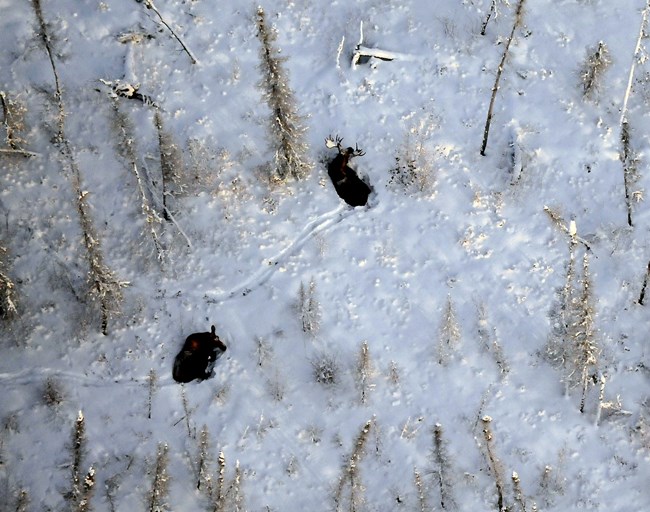
NPS/Matt Cameron
While most people think of moose droppings as the characteristic hard, oblong nuggets, moose scat in the summer is loose and resembles a dairy cow patty since they are eating fresh growing vegetation. In the winter, moose switch to eating woody material, which is when you find hard moose nuggets. There’s so little nutrition in the winter browse, moose nuggets are mostly wood and have even been used as incense.16
Do the Dewlap
Both male and female moose have dewlaps, also known as a “bell,” which grow under their jaw. Young males often have the largest bells,17 and their exact function remains a mystery. In other ungulates, dewlaps have been linked with heat exchange.18
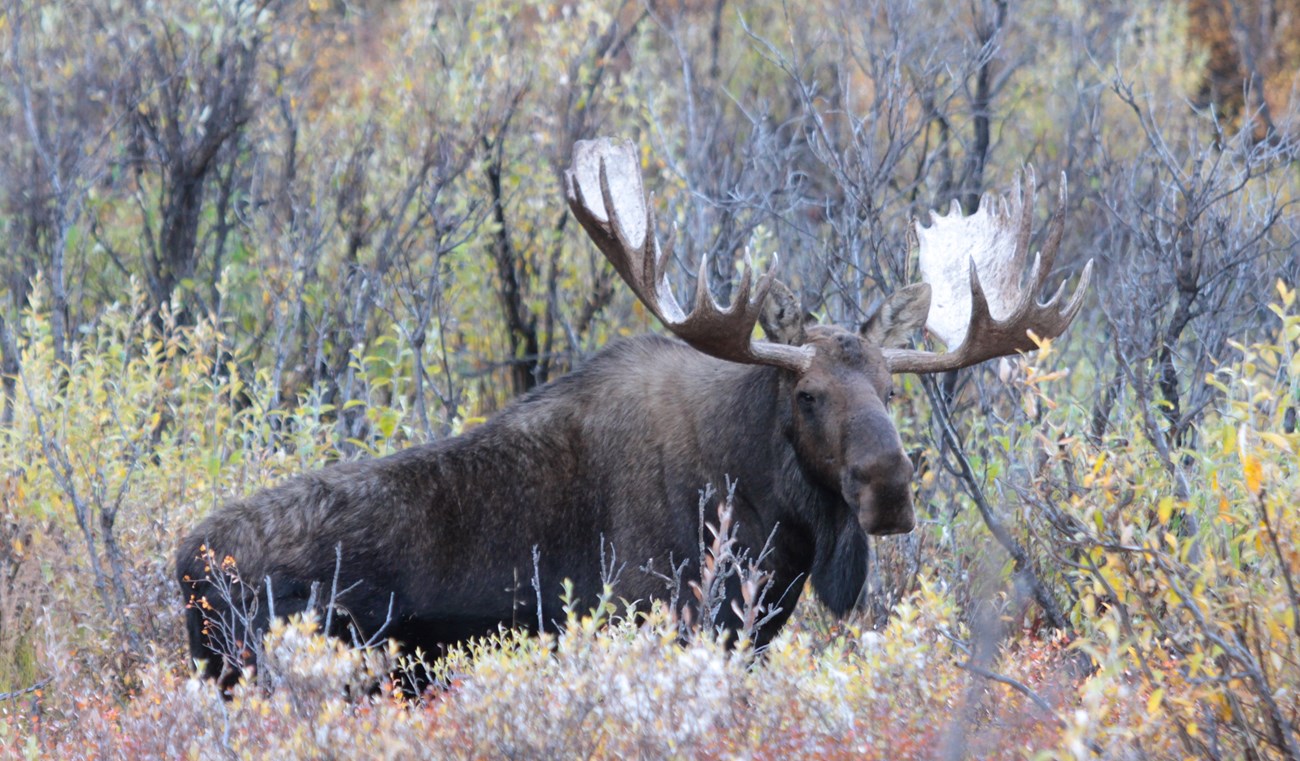
Dylan Schertz
Numerals correspond to superscript in ‘Did You Know’ factoids.
1. Personal communication, 2018. Professor Kris Hundertmark, University of Alaska Fairbanks.
2. Gasaway, William C. 1974. “Moose Antlers: How Fast Do They Grow?” Miscellaneous Publication. Alaska Department of Fish and Game, Fairbanks.
3. Salwey, Mary Kay. 2005. “Amazing antlers: fast growing bone a seasonal phenomenon.” Alaska Fish and Wildlife News, Alaska Department of Fish and Game.
4. Gasaway, William C, and J W Coady. 1974. “Review of Energy Requirements and Rumen Fermentation in Moose and Other Ruminants.” Naturaliste Canadien 101: 227-62.
5. Renecker, Lyle A., and Robert J. Hudson. 1986. “Seasonal Energy Expenditures and Thermoregulatory Responses of Moose.” Canadian Journal of Zoology 64 (2): 322-27.
6. National Climatic Data Center. National Climate Extremes Committee: Existing Records. https://www.ncdc.noaa.gov/extremes/ncec/records Retrieved 12 September 2018.
7. Monteith, Kevin L., Robert W. Klaver, Kent R. Hersey, A. Andrew Holland, Timothy P. Thomas, and Matthew J. Kauffman. 2015. “Effects of Climate and Plant Phenology on Recruitment of Moose at the Southern Extent of Their Range.” Oecologia 178 (4): 1137-48.
8. Tape, Ken D., David D. Gustine, Roger W. Ruess, Layne G. Adams, and Jason A. Clark. 2016. “Range Expansion of Moose in Arctic Alaska Linked to Warming and Increased Shrub Habitat.” Plos One 11 (4): e0152636.
9. Yesner, D. 2007. The Broken Mammoth Site. In Foragers of the Terminal Pleistocene in North America, edited by R.B. Walker and B.N. Driskell, pp. 15-31. University of Nebraska Press, Lincoln.
10. Miquelle, Dale G. 1990. “Why Don’t Bull Moose Eat during the Rut?” Behavioral Ecology and Sociobiology 27 (2): 145-51.
11. Franzmann, Albert W., and Charles C. Schwartz. 1985. “Moose Twinning Rates: A Possible Population Condition Assessment.” The Journal of Wildlife Management 49 (2): 394-96.
12. Joly, Kyle, Tim Craig, Matthew D Cameron, Adrian E Gall, and Mathew S Sorum. 2017. “Lying in Wait: Limiting Factors on a Low-Density Ungulate Population and the Latent Traits That Can Facilitate Escape from Them.” Acta Oecologica 85. Elsevier: 174-83.
13. Risenhoover, Kenneth L. 1986. “Winter Activity Patterns of Moose in Interior Alaska.” The Journal of Wildlife Management 50 (4): 727-34.
14. MacCracken, James G., Victor Van Ballenberghe, and James M Peek. 1997. “Habitat Relationships of Moose on the Copper River Delta in Coastal South Central Alaska.” The Wildlife Society, no. 136: 3-52.
15. Schwartz, Charles C., and Albert W. Franzmann. 1989. “Bears, Wolves, Moose, and Forest Succession, Some Management Considerations on the Kenai Peninsula, Alaska.” Alces 25: 1-10.
16. Medred, Craig. “Dining on moose nuggets: Yummy or yucky?” Anchorage Daily News, June 10, 2012. Accessed September 14, 2018. https://www.adn.com/uncategorized/article/dining-moose-nuggets-yummy-or-yucky/2012/06/11/
17. Timmermann, H. R. 1979. Morphology and Anatomy of the Moose (Alces alces) Bell and Its Possible Functions. Thesis.
18. Bro Jørgensen, Jakob. 2016. “Evolution of the Ungulate Dewlap: Thermoregulation Rather than Sexual Selection or Predator Deterrence?” Frontiers in Zoology 13 (1).
Download the Moose: Did You Know? PDF
Tags
- alaska public lands
- gates of the arctic national park & preserve
- yukon - charley rivers national preserve
- alaska
- wildlife
- wildlife biologist
- wildlife biology
- gates of the arctic national park and preserve
- yukon-charley rivers national preserve
- gates of the arctic
- yukon-charley rivers
- yukon river
- moose
- moose survey
- migration
- brooks range
- research
- biology
- biology animals
- wilderness
- wilderness alaska
